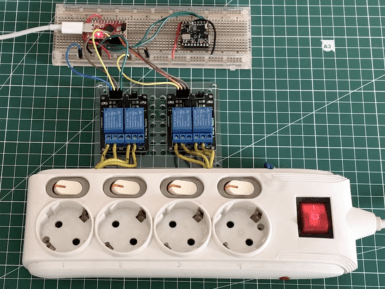
Bluetooth Low Energy 4.0 Module - HM-10
Save 20%Bluetooth 4.0 module (Low Energy) compliant with ISM 2.4 GHz, master/slave operating mode with transparent data transmission, based on the Texas Instruments CC2541 chip with 256K of Flash memory and 8K of RAM.
Overview
This is a Bluetooth 4.0 (Low Energy) module compliant with ISM 2.4 GHz, with master/slave mode of operation and transparent data transmission, based on the Texas Instruments CC2541 chip with 256K Flash memory and 8K RAM.
It can be controlled through simple AT commands (via UART) or programmed with custom applications. Ideal for use in projects where Bluetooth connection is needed, such as between microcontroller and PC. Power supply ranges between 2V and 3.6Vdc.
Note: SMT mounting.
Tech specs
- Bluetooth 4.0 module compliant with ISM 2.4 GHz (HM-10)
- Uses Texas Instruments CC2541 SoC chip with 256K Flash memory and 8K RAM
- Supports master and slave modes
- RX standard gain: 19.6 mA
- TX -6 dBm: 24 mA
- Frequency: 2402 - 2483.5 MHz in 20 kHz steps
- Modulation and Data Rate: 1 Mbps, GFSK
- Number of channels: 40
- Output power: -23 to 4 dBm
- Reception sensitivity: -93dBm/-87dBm
- Stack: ATT, GATT, SMP, L2CAP, GAP
- Range: over 70 meters 10-bit ADC
- Serial interface: UART/SPI Wake-up interrupt, Watchdog Timer
- AES Security Coprocessor
- Power supply: ranges between 2V and 3.6V
- VDD ripple: 100mV max
- Current consumption (at 25°C with VDD = 3V):
- Power Mode 3 (External Interrupts): 0.4uA
- Power Mode 2 (SleepTimerOn): 0.9uA
- Power Mode 1 (3-μs Wake-Up): 235uA
- RX Standard Gain: 19.6mA
- TX -6 dBm: 24mA
- TX 0 dBm: - - Operating temperature: -40°C to +85°C
- Dimensions (mm): 27x13x1.6
- Weight: 5 grams.
Conformities
Get Inspired

As Jallson Suryo discusses in his project, adding voice controls to our appliances typically involves an internet connection and a smart assistant device such as Amazon Alexa or Google Assistant. This means extra latency, security concerns, and increased expenses due to the additional hardware and bandwidth requirements. This is why he created a prototype based on an Arduino Nicla Voice that can provide power for up to four outlets using just a voice command. Suryo gathered a dataset by repeating the words “one," “two," “three," “four," “on," and “off” into his phone and then uploaded the recordings to an Edge Impulse project. From here, he split the files into individual words before rebalancing his dataset to ensure each label was equally represented. The classifier model was trained for keyword spotting and used Syntiant NDP120-optimal settings for voice to yield an accuracy of around 80%. Apart from the Nicla Voice, Suryo incorporated a Pro Micro board to handle switching the bank of relays on or off. When the Nicla Voice detects the relay number, such as “one” or “three," it then waits until the follow-up “on” or “off” keyword is detected. With both the number and state now known, it sends an I2C transmission to the accompanying Pro Micro which decodes the command and switches the correct relay. To see more about this voice-controlled power strip, be sure to check out Suryo’s Edge Impulse tutorial.





